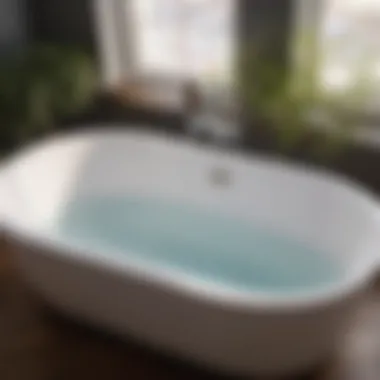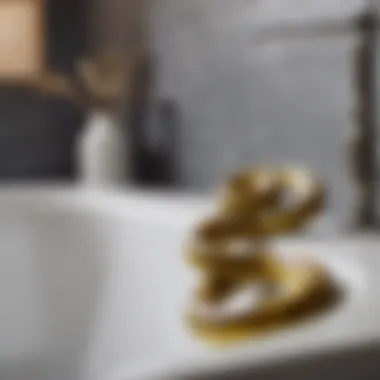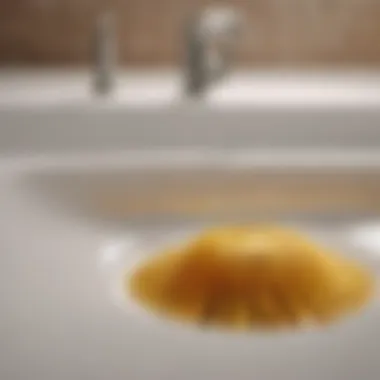Expert Guide: Best Methods to Unclog a Bathroom Tub Effectively


Materials:
- Rubber gloves
- Plunger
- Wire hanger
- Baking soda
- Vinegar
- Boiling water
- Drain snake
DIY Steps:
- Put on rubber gloves to protect hands.
- Use a plunger to create pressure and dislodge the clog.
- Straighten a wire hanger and use it to pull out hair and debris from the drain.
- Pour baking soda followed by vinegar down the drain to break up clogs.
- Flush with boiling water to wash away residue.
- If needed, use a drain snake to physically remove any stubborn blockages.
Technical Aspects:
- Timing specifics: Allocate 15-30 minutes depending on the severity of the clog.
- Critical techniques: Ensure a tight seal when using the plunger for effective pressure.
- Tools: Maintenance appropriate tools like a plunger or drain snake for optimal results.
DIY Project Process:
- Start by wearing gloves for protection.
- Begin with the plunger, applying firm pressure up and down vigorously.
- Proceed with the wire hanger to fish out any debris visible near the surface.
- Introduce the baking soda and vinegar mixture for a natural chemical reaction.
- Follow up with boiling water to clear out the loosened clog.
- Utilize the drain snake for deeper clogs if necessary.
Troubleshooting Tips:
- If the clog persists, ensure the plunger has a tight seal and repeat the process.
- For stubborn blockages, repeat the baking soda and vinegar method with longer reaction time.
- In case of severe clogs, consider professional assistance for thorough unclogging.
Understanding the Causes of Tub Clogs
Unclogging a bathroom tub is a common household issue that can disrupt daily routines and cause frustration among homeowners. Understanding the causes of tub clogs is paramount in addressing and preventing this inconvenience effectively. One of the primary culprits behind tub clogs is hair build-up. Hair accumulation in drains can impede water flow, leading to slow drainage and eventual blockages. Moreover, soap scum accumulation is another prevalent cause of tub clogs. The combination of soap residue and mineral deposits can solidify within pipes, diminishing the functionality of the drain. Additionally, foreign objects mistakenly washed down the drain can also result in blockages that necessitate immediate attention.
Hair Build-Up


Effects on Drainage
Hair build-up poses a significant threat to optimal drainage in a bathroom tub. As hair tangled within the drain collects over time, it restricts the passage of water, causing it to back up and create a pool in the tub. This not only impedes drainage but also leads to unsanitary conditions and unpleasant odors in the bathroom. Addressing hair build-up promptly is crucial to maintaining a smoothly functioning plumbing system.
In terms of prevention methods, installing a drain protector can effectively trap hair before it enters the drain, minimizing the accumulation of hair clogs. Regularly cleaning the drain and implementing a monthly maintenance routine can further prevent hair build-up and ensure long-term drainage efficiency.
Prevention Methods
Implementing prevention methods for hair build-up is essential for maintaining clear drains and preventing clogs. One effective prevention technique is using chemical drain cleaners specifically formulated to dissolve hair and debris, facilitating proper water flow. Alternatively, natural remedies like a vinegar and baking soda solution can break down hair clogs without harsh chemicals, promoting eco-friendly drain maintenance.
Each prevention method has its advantages and disadvantages. While chemical drain cleaners offer quick results, they may contain harsh ingredients that can damage pipes over time. On the other hand, natural remedies are safer for the environment but might require more frequent applications to achieve the same level of effectiveness.
Soap Scum Accumulation
Impact on Drain Functionality
The accumulation of soap scum within bathroom tub drains can significantly impair drain functionality. As soap scum mixes with hard water minerals, it forms a sticky residue that adheres to pipe walls, reducing the diameter available for water flow. This can result in slow drainage, recurring clogs, and potential pipe corrosion if left unaddressed.
To combat soap scum accumulation, employing proper cleansing techniques is crucial. Regularly flushing the drain with hot water can help dissolve soap residue and prevent its build-up, promoting consistent drainage performance.
Cleansing Techniques
Cleansing techniques play a vital role in preserving optimal drain functionality and preventing soap scum build-up. Using commercial drain cleaners designed to break down soap scum effectively can mitigate drainage issues and extend the lifespan of plumbing systems. Alternatively, homemade remedies such as a vinegar and baking soda mixture can serve as gentle yet efficient cleansers for maintaining clean and clear drains.
Each cleansing technique offers unique features to address soap scum. Commercial drain cleaners are often fast-acting and require minimal effort, while natural cleansing agents are biodegradable and pose fewer risks to both plumbing and the environment.


Foreign Objects
Identification
Foreign objects accidentally entering bathroom tub drains can lead to blockages that impede water flow and disrupt daily activities. Identifying these objects promptly is crucial to preventing extensive clogs and potential damage to the plumbing system. Common foreign objects include hair accessories, jewelry, and small toys that inadvertently find their way into the drain.
Utilizing specialized tools like drain snakes or tweezers can aid in effectively identifying and removing foreign objects from the drain, restoring proper drainage and preventing future blockages.
Removal Strategies
Implementing strategic removal strategies for foreign objects is essential in maintaining unobstructed drainage in bathroom tubs. By carefully extracting lodged items with gentle yet effective techniques, homeowners can prevent the escalation of clogs and ensure the smooth operation of their plumbing systems.
Mitigating the risk of foreign objects in drains involves proactive measures such as using hair strainers and educating household members on the importance of responsible drain usage. Regular inspections of drains can also help identify potential foreign objects before they cause blockages, allowing for timely removal and minimal disruption to daily routines.
Effective Methods for Unclogging
When it comes to unclogging a bathroom tub efficiently, understanding effective methods is crucial. In this article, we delve deep into practical techniques that can address common blockages and ensure optimal drainage for your tub. By exploring a range of solutions, readers can gain confidence in dealing with this household issue effectively.
Chemical Drain Cleaners
Application Guidelines
Chemical drain cleaners play a significant role in tackling tough clogs in bathroom tubs. Their unique formulas are designed to break down hair, soap scum, and other debris effectively, restoring proper drainage. Application guidelines are essential for maximizing the effectiveness of these cleaners. It is crucial to follow instructions carefully to avoid damage to pipes and fixtures. The key characteristic of application guidelines lies in their specificity, providing users with step-by-step directions for safe and efficient usage. Following these guidelines diligently is a popular choice for readers looking to resolve clogging issues promptly. While the unique feature of application guidelines offers simplicity, their disadvantage may lie in the potential health and environmental risks associated with chemical cleaners.
Recommended Products


Choosing the right chemical drain cleaner is paramount in achieving successful results. Recommended products are tailored to address different types of clogs, ensuring thorough cleaning and optimal performance. The key characteristic of recommended products is their powerful formulas that can dissolve stubborn blockages effectively. This choice is popular among those seeking quick and convenient solutions for unclogging their bathroom tubs. The unique feature of these products lies in their versatility, catering to various severity levels of clogs. While they offer prompt results, one disadvantage may be the strong chemical odors and fumes emitted during usage.
Natural Remedies
For those looking for environmentally-friendly unclogging options, natural remedies such as vinegar and baking soda provide effective solutions. These alternative methods offer a gentle yet powerful way to address clogs without harsh chemicals. Vinegar and baking soda solution is a popular choice due to its natural cleaning properties. The unique feature of this remedy is its ability to create a foaming reaction that helps break down debris in the drain. While advantageous for eco-conscious readers, one potential disadvantage is the need for repeated applications for severe clogs.
Hot Water Flushing
Hot water flushing is another natural remedy that can help dislodge minor clogs in bathroom tubs. The key characteristic of hot water flushing is its simplicity and accessibility. This method is beneficial for regular maintenance to prevent future blockages. The unique feature of hot water flushing is its ability to clear partial obstructions and maintain drain cleanliness. While advantageous for quick fixes, the disadvantage may be its limited effectiveness against stubborn or deep-seated clogs.
Plumbing Tools
In addition to chemical cleaners and natural remedies, plumbing tools such as plungers and augers play a vital role in unclogging bathroom tubs. Plungers are essential for creating pressure to dislodge blockages, making them a popular choice for minor clogs. The key characteristic of plungers lies in their simple yet effective design, allowing users to exert force on the clog for removal. While advantageous for immediate results, one disadvantage may be their limitations in tackling more severe blockages.
Augers
Augers are specialized tools designed to reach deep into pipes to break apart stubborn clogs. Their unique feature lies in their ability to maneuver through intricate plumbing systems, ensuring thorough cleaning. This choice is beneficial for readers dealing with persistent clogs that require professional-grade solutions. While augers offer comprehensive clog removal, their disadvantage may be the complexity of usage for individuals with limited plumbing experience.
Preventive Measures for Future Clogs
In the realm of bathroom maintenance, preventive measures play an integral role in ensuring the longevity and efficiency of your tub drainage system. By addressing these preventive measures, you not only alleviate the hassle of recurrent clogs but also safeguard your plumbing infrastructure from potential damage. Implementing these strategies enhances the overall functionality of your bathroom tub, allowing for a seamless drainage experience. With a proactive approach to maintenance, you can diminish the occurrence of clogs and uphold the condition of your plumbing system.
Regular Maintenance
- Drain Protectors: When discussing drain protectors, we delve into a pivotal aspect of preventative maintenance for future clogs. Drain protectors serve as a physical barrier against debris and hair accumulation, preventing blockages that can impede water flow. Their key characteristic lies in their ability to trap foreign particles while allowing water to flow freely, maintaining optimal drainage. The unique feature of drain protectors is their affordability and ease of installation, making them a popular choice for individuals seeking a simple yet effective solution to prevent clogs.
- Monthly Cleaning Routine: A structured monthly cleaning routine is a fundamental aspect of maintaining a clog-free bathroom tub. This practice involves inspecting and cleansing the drain area to remove any buildup of hair, soap scum, or debris that could potentially lead to blockages. The key characteristic of this routine is its regularity, ensuring that any emerging issues are swiftly addressed before they escalate. The unique feature of a monthly cleaning routine is its preventive nature, preemptively tackling potential clog culprits and preserving optimal drainage. Although it requires diligence, this practice reaps long-term advantages by promoting a smoothly functioning plumbing system.
Hair Strainers
- Installation Steps: When considering hair strainers, the installation process emerges as a crucial contributing factor to the prevention of future clogs. Proper installation ensures that the strainer effectively captures hair and other particles, preventing them from entering and obstructing the drain. The key characteristic of installation steps lies in their simplicity and accessibility, allowing even novice homeowners to set up the strainer with ease. The unique feature of installing a hair strainer is its immediate impact on reducing the likelihood of clogs, offering a proactive barrier against potential blockages.
- Benefits: The benefits of using hair strainers extend beyond mere clog prevention, encompassing enhanced drainage efficiency and minimized plumbing issues. The key characteristic of these benefits is their cost-effectiveness, providing a practical solution that saves both time and resources in the long run. The unique feature of employing hair strainers is their adaptability to various drain types, making them a versatile choice for individuals seeking a customized approach to maintaining a clear and functional tub drain.
Professional Inspections
- Frequency Recommendations: Professional inspections come with specific frequency recommendations that contribute significantly to preventing future clogs. By adhering to these guidelines, homeowners can detect and address potential plumbing issues before they escalate, ensuring the continuous functionality of their drainage system. The key characteristic of frequency recommendations is their ability to provide proactive maintenance, preemptively identifying and resolving hidden concerns. The unique feature of following these recommendations is the peace of mind it offers, knowing that your plumbing system undergoes regular checks to maintain optimal performance.
- Signs of Potential Issues: Recognizing the signs of potential plumbing issues is essential in preventing future clogs and maintaining a well-functioning bathroom drain system. By understanding these indicators, such as slow drainage or unpleasant odors emanating from the drain, homeowners can promptly seek professional assistance to address underlying problems. The key characteristic of these signs lies in their warning nature, alerting individuals to impending issues that require immediate attention. The unique feature of identifying potential problems is the proactive stance it promotes, enabling timely interventions to prevent major disruptions and costly repairs.







